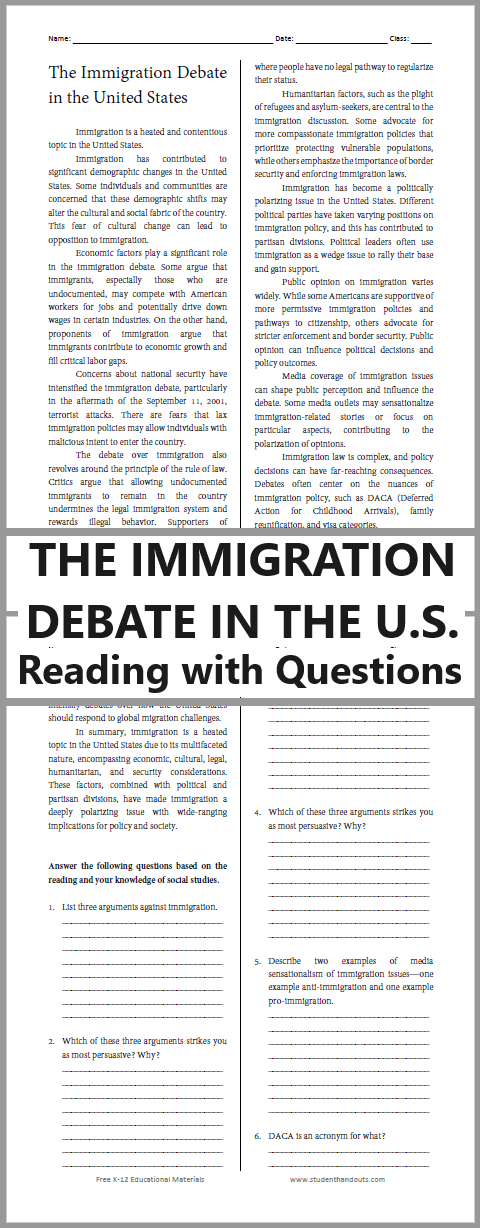| Immigration Debate Reading with Questions |
|---|
| www.studenthandouts.com ↣ U.S. History ↣ Polarization ↣ Polarization Worksheets |
|
Immigration is a heated and contentious topic in the United States. Immigration has contributed to significant demographic changes in the United States. Some individuals and communities are concerned that these demographic shifts may alter the cultural and social fabric of the country. This fear of cultural change can lead to opposition to immigration.  Economic factors play a significant role in the immigration debate. Some argue that immigrants, especially those who are undocumented, may compete with American workers for jobs and potentially drive down wages in certain industries. On the other hand, proponents of immigration argue that immigrants contribute to economic growth and fill critical labor gaps.
Economic factors play a significant role in the immigration debate. Some argue that immigrants, especially those who are undocumented, may compete with American workers for jobs and potentially drive down wages in certain industries. On the other hand, proponents of immigration argue that immigrants contribute to economic growth and fill critical labor gaps.Concerns about national security have intensified the immigration debate, particularly in the aftermath of the September 11, 2001, terrorist attacks. There are fears that lax immigration policies may allow individuals with malicious intent to enter the country. The debate over immigration also revolves around the principle of the rule of law. Critics argue that allowing undocumented immigrants to remain in the country undermines the legal immigration system and rewards illegal behavior. Supporters of immigration reform contend that the existing system is flawed and often creates situations where people have no legal pathway to regularize their status. Humanitarian factors, such as the plight of refugees and asylum-seekers, are central to the immigration discussion. Some advocate for more compassionate immigration policies that prioritize protecting vulnerable populations, while others emphasize the importance of border security and enforcing immigration laws. Immigration has become a politically polarizing issue in the United States. Different political parties have taken varying positions on immigration policy, and this has contributed to partisan divisions. Political leaders often use immigration as a wedge issue to rally their base and gain support. Public opinion on immigration varies widely. While some Americans are supportive of more permissive immigration policies and pathways to citizenship, others advocate for stricter enforcement and border security. Public opinion can influence political decisions and policy outcomes. Media coverage of immigration issues can shape public perception and influence the debate. Some media outlets may sensationalize immigration-related stories or focus on particular aspects, contributing to the polarization of opinions. Immigration law is complex, and policy decisions can have far-reaching consequences. Debates often center on the nuances of immigration policy, such as DACA (Deferred Action for Childhood Arrivals), family reunification, and visa categories. International events and regional developments, such as conflicts, economic crises, and natural disasters, can lead to increased immigration flows. These events can intensify debates over how the United States should respond to global migration challenges. In summary, immigration is a heated topic in the United States due to its multifaceted nature, encompassing economic, cultural, legal, humanitarian, and security considerations. These factors, combined with political and partisan divisions, have made immigration a deeply polarizing issue with wide-ranging implications for policy and society. Answer the following questions based on the reading and your knowledge of social studies. 1. List three arguments against immigration. Answers will vary. 2. Which of these three arguments strikes you as most persuasive? Why? Answers will vary. 3. List three arguments for immigration. Answers will vary. 4. Which of these three arguments strikes you as most persuasive? Why? Answers will vary. 5. Describe two examples of media sensationalism of immigration issues—one example anti-immigration and one example pro-immigration. Answers will vary. 6. DACA is an acronym for what? Deferred Action for Childhood Arrivals Click here to print (PDF file). Questions and answers are above. |
 |  |  |  |  |  |
| www.studenthandouts.com ↣ U.S. History ↣ Polarization ↣ Polarization Worksheets |








